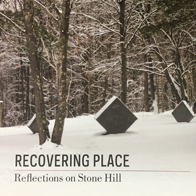
July 4–October 10, 2016
butterfly
Mourning Cloak butterfly
Northwest Massachusetts, Fall 2015
Private collection
TRANSCRIPT:
I feel that there is much to be said for the Celtic belief that the souls of those whom we have lost are held captive in some inferior being, in an animal, in a plant, in some inanimate object, and so effectively lost to us until the day . . . when we happen to pass by the tree or to obtain possession of the object that forms their prison. Then they start and tremble, they call us by our name, and as soon as we have recognized their voice, the spell is broken.
—Marcel Proust, In Search of Lost Time (1913)
A Mourning Cloak butterfly (Nymphalis antiopa, first classified and given its Latin name in 1758 by Linnaeus) flutters by on an early spring morning on Stone Hill. A long-lived species of Lepidoptera that winters over and so is spared the travail of migrating, it is a reassuring harbinger of spring, silently announcing that the snowy season is slowly retreating and Stone Hill is coming to life once again. The Victorian deep purple mourning cloak that lends its common name nearly, but not quite, masks a brilliant sunshiny yellow undercoat, punctuated by sky-blue iridescent spots. Is this velvety butterfly presaging sadness or promising joy? If grieving, its passing is rendered soft and light. If joyful, my own mood is uplifted, like the butterfly itself, on the currents of hilltop breezes. Because it is one of the rare creatures of nature that will actually caress my hand, I am sustained, like Proust, by the Celtic belief in departed souls and by all those other ancient tales about butterflies, loss, and the return of life.
.jpg)
Michael Ann Holly is the Consulting Director and Starr Director Emeritus of the Research and Academic Program (RAP) at the Clark Art Institute (after serving as director for fourteen years). When not directing RAP or teaching in the graduate program in art history at Williams College, she writes books and essays on the critical theory of art history.
Recovering Place: Reflecting on Stone Hill
By Mark C. Taylor
An illustrated book chronicling the land art and sculptures created by Mark C. Taylor at his home in the Berkshire hills, echoing themes found in the exhibition. Supported in part by Herbert A. Allen, Jr. and the Clark Art Institute and published by Columbia University Press. Call the Museum Store at 413 458 0520 to order.

